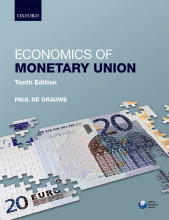The benefits of a common currency
10 important questions on The benefits of a common currency
Via which two ways does a common currency entail gains in economic efficiency?
2. elimination of risk coming from the uncertain future movements of exchange rates
What is the aim of SEPA?
Describe the TARGET system
- Higher grades + faster learning
- Never study anything twice
- 100% sure, 100% understanding
How does a common currency benefit consumers?
Wolszczak-Derlacz (2006) find that price convergence happened before 1999, since the EU it has stopped. Studies show that the euro did not reduce price dispersion. What are possible reasons for this?
2. retail business is still very much segmented nationally, in most countries a few supermarkets dominate
How might the theory of the firm invalidate the reasoning that eliminating exchange rate uncertainty increases welfare?
Explain what tail risks are and how they motivated EU leaders to move into an MU
Quick depreciation of Italian lira in 1990. EU leaders wanted in MU because:
- it is difficult to manage exchange rates properly in a world of free capital mobility
- exchange rate movements were viewed as causes of asymmetric disturbances
Explain the difference between exogenous and endogenous growth models
In endogenous growth models, capital accumulation increases productivity. A lower r causes capital accumulation, capital stock productivity increases, growth is stimulated. Both in the short and long run the growth rate increases.
Describe three benefits of a common currency
2. the currency is also held as international reserve by foreign central banks, foreign holders face the exchange risk > easier finance can lead governments to make excessive use of it, e.g. the US running unsustainable consumption booms
3. the currency boosts activity for domestic financial markets, attracting investors.
> UK also has booming financial activities, without euro
Why does the decline in exchange risk not necessarily reduce systemic risk?
The question on the page originate from the summary of the following study material:
- A unique study and practice tool
- Never study anything twice again
- Get the grades you hope for
- 100% sure, 100% understanding






























